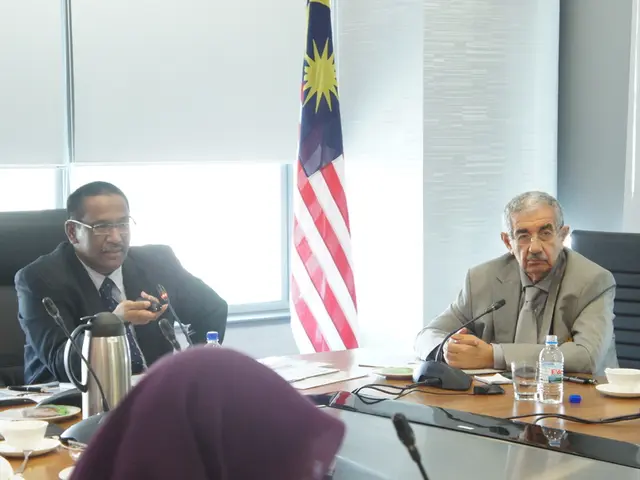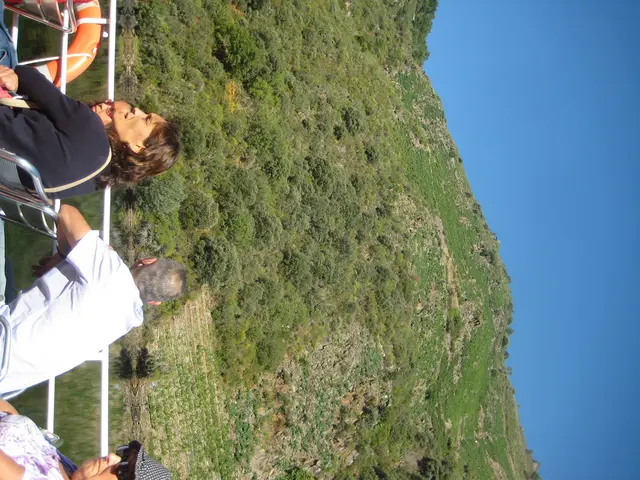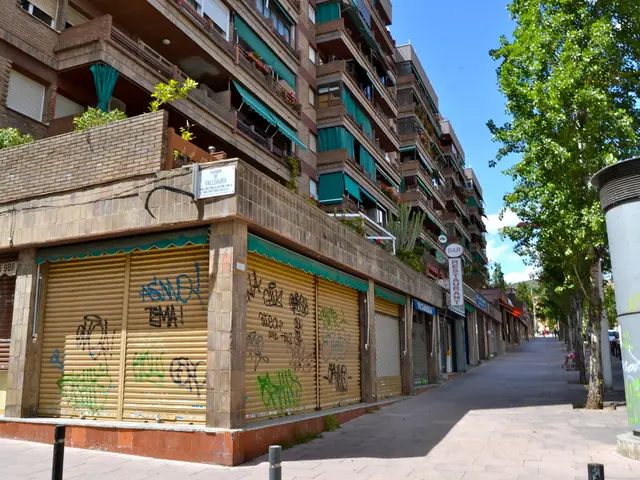Unforeseen alliances: Japan and Southern Estonia unite in the Tartu 2024 European Capital of Culture
Creating Connections Across Continents: Japan and Estonia's Unlikely Artistic Bond
Facebook* Instagram* Twitter* Email
Hold onto your hats, folks! Never thought you'd hear about a close friendship between Japan and the tiny Northern European nation of Estonia? Well, buckle up and get ready for an inspiring tale of creativity, collaboration, and cultural exploration. Despite being separated by over 8,000 km and seven time zones, these two vastly different nations have syncronized their worlds as sources of inspiration for artists, curators, and cultural organizers in their respective countries. In 2024, the European Capital of Culture Tartu 2024 programme is set to celebrate a year-long celebration of art and creativity, featuring numerous projects born from collaborations between Estonian and Japanese artists.
This exciting partnership came to fruition thanks to Japan's extensive cultural policies aiming to spread its culture worldwide. Various organizations like the EU-Japan Fest have been established to support cross-cultural exchange between the European Union and Japan since the 1990s. The EU-Japan Fest provides funding to European Capitals of Culture and other significant cultural collaborations between Europe and Japan.
Kati Torp, the artistic director of Tartu 2024, acknowledges the fruits of these policies, with Japanese artists being more visible on the international stage and possessing strong cultural networks. She goes on to mention that many EU-Japan Fest grants support various projects and initiatives in the Tartu 2024 programme.
However, these artistic connections to Japan in the programme did not occur overnight. Rather, they have developed organically based on artistic decisions. "Take a closer look at our programme, and you'll see the fruits of long-term labor," Torp explained. She highlights that major Japanese artists or projects in the programme already have pre-existing connections to Estonia.
One of the highlights of the European Capital of Culture year in Southern Estonia is Japanese leading electronic music composer and visual artist Ryoji Ikeda's solo exhibition at the Estonian National Museum. Ikeda has exhibited his work in Estonia before, and this highly anticipated audiovisual experience, opening in November, is poised to be another success.
Torp personally coordinated Ikeda's previous exhibition in Estonia, "Supersymmetry," at the Kumu Art Museum in 2015-2016. This previous collaboration has built a foundation for the two parties to come together again. Torp emphasizes the importance of mutual trust and having good standing in the artistic community.
Ikeda will create two new works for Tartu 2024: an installation based on his collaboration with the University of Tartu Institute of Genomics' Estonian Biobank, and a sound installation created in collaboration with the Estonian Philharmonic Chamber Choir. Additionally, one artwork, the audiovisual installation "data-verse," will be exhibited.
'Art is a language that can speak of things that are often difficult to communicate,' Kati Torp explained, adding that Ikeda works with data from the Institute of Genomics' biobank to create large-scale room installations. A new music piece written by Ikeda will also be performed by the Estonian Philharmonic Chamber Choir.
A unique festival celebrating the art of idling, or "molutamine" in Estonian, is taking place during the European Capital of Culture year in Võru County in Southern Estonia. Aigu Om, meaning "there is time" or "take time" in the Võro language, is bigger than ever and features activities throughout three parishes over a week. This year, the focus is on Japan and its culture.
Aigu Om is not a traditional festival with big stages and massive crowds. Instead, it is a community music-word-forest event that takes place in natural environments and offers an opportunity for everyone to contribute. The festival emphasizes unity as its message.
"Aigu Om!" means take your time, or there is time. This idea has become the motto of the Võru region and is the festival's core message. Over the course of a week, from 15-21 July, visitors can enjoy smoke saunas, herbal healing, and Japanese cooking workshops. The musical piece "Mõts/Mori/Forest" will have its world premiere in a cosy barn-concert hall in the village of Viitina during Aigu Om.
The festival is seeking to identify points of intersection between the two cultures, such as forest contemplation practices, smoke saunas, and collaborative works by representatives of both cultural spheres. The organizer of Aigu Om, Estonian folk singer-songwriter Mari Kalkun, has visited Japan seven times and has formed a unique bond with the country, which also paved the way for this year's festival.
"The visits have always been incredibly inspiring, and our Japanese guests are always amazed by the nature and saunas of Võrumaa. Thus, our starting point was mutual inspiration," Kalkun said. She hopes to establish such meetings through the Aigu Om festival.
In addition to the unique festival, traditional community-based activities remain. Aigu Om workshops, contemplations, concerts, and hikes invite visitors to immerse themselves in the rich local culture, the stories of the local people, and the enchanting nature of Võrumaa.
From this, it seems that there is a mutual interest and understanding between Japan and Estonia. Both nations share a fondness for nature, forests, and technology. While the reasons for this interest remain unclear, it's evident that Tartu and Southern Estonia benefit from positive relationships with Japanese artists and organizations.
"We offer an accessible, yet different space," Kati Torp said, adding that Estonia values topics like nature, folklore, heritage, and reflects what Japan has from another angle.
Mari Kalkun emphasizes that Southern Estonia can offer nature, relaxation, and the art of resting the mind and body. She believes that Estonia can teach skills of relaxation and mindset benefits, as well as share its expertise in the smoke sauna tradition.
If you're interested in experiencing Japanese culture, mark your calendars for the following events:
- Japanese forest bathing experience: 18 May, 29 June, 27 July, 17 August in Nõo parish
- Shiro Takatani/Dumb Type theatre play "Tangent", 4-5 June in Tartu
- Aigu om! (Time Enough!), 15-21 July, in Rõuge, Võru, and Antsla parish
- A Celebration of the Heavenly grounds, 16-25 August, in Põlva parish
- Refresh. Estonian, Lithuanian, and Japanese textile art. 19 August - 20 September in Tartu
- Performative installation "Peal kiri peal", 12, 14 September in Viljandi
- Ryoji Ikeda's solo exhibition, 2 November - 2 March in Tartu
Read also: The art of survival - Tartu's long road towards the European Capital of Culture**
- Share294
- Tweet
- In 2024, Estonia's Tartu 2024 programme will feature numerous projects born from collaborations between Estonian and Japanese artists, as part of the European Capital of Culture celebration.
- Grants from the EU-Japan Fest support various projects and initiatives in the Tartu 2024 programme, as part of Japan's extensive cultural policies aimed at spreading its culture worldwide.
- Japanese leading electronic music composer and visual artist Ryoji Ikeda will create two new works for Tartu 2024, including a collaboration with the University of Tartu Institute of Genomics' Estonian Biobank.
- Mari Kalkun, organizer of the Võru region's unique Aigu Om festival, has formed a unique bond with Japan and has visited the country seven times.
- The Aigu Om festival emphasizes unity as its message and invites visitors to immerse themselves in the rich local culture, the stories of the local people, and the enchanting nature of Võrumaa.
- Apart from the festival, traditional community-based activities like smoke saunas, herbal healing, and Japanese cooking workshops will be offered during Aigu Om.
- Yutaka, aLinkedIn user, is expected to attend the Japanese forest bathing experience, Shiro Takatani/Dumb Type theatre play "Tangent," Aigu om! (Time Enough!), A Celebration of the Heavenly grounds, Refresh, Performative installation "Peal kiri peal," and Ryoji Ikeda's solo exhibition in 2024.
- The Estonian lifestyle, which includes its appreciation for nature, relaxation, smoke saunas, and the art of resting the mind and body, resonates with the Japanese population.
- Estonian fashion-and-beauty, food-and-drink, and travel industries can benefit from the burgeoning cultural relationships with Japan, as Estonia offers a different and accessible space that reflects Japan's values from another angle.




